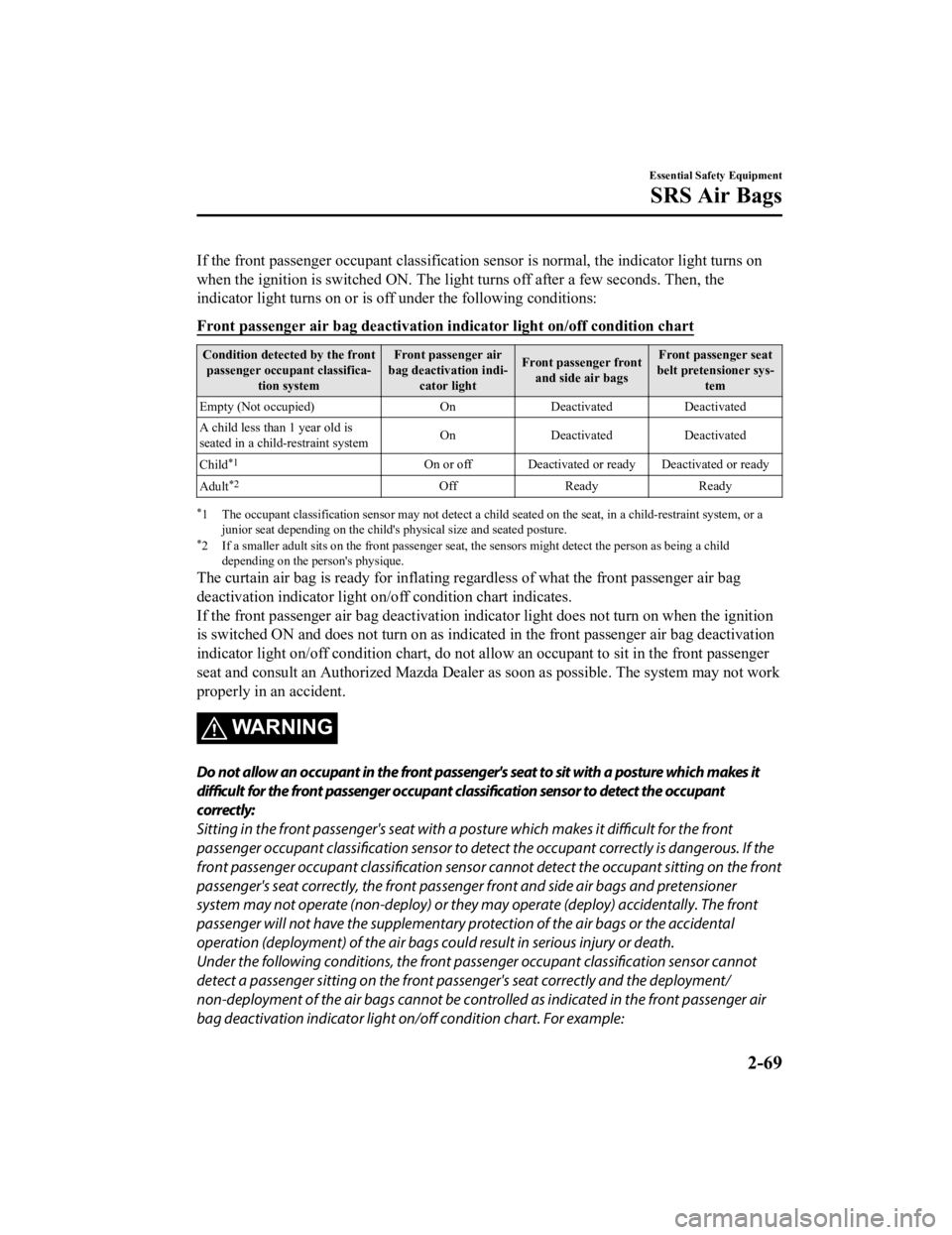MAZDA MODEL 6 2021 Manual Online
Manufacturer: MAZDA, Model Year: 2021, Model line: MODEL 6, Model: MAZDA MODEL 6 2021Pages: 634, PDF Size: 71.37 MB
Page 81 of 634

Limitations to side collision detection:
The following illustrations are examples of side collisions that may not be detected as
severe enough to deploy the SRS air bag equipment.
Side impacts involving trees or poles Side impacts with two-wheeled vehicles
Roll-over (Without Front Passenger Occupant Classification System)
(With Front Passenger Occupa
nt Classification System)
Limitations to ro ll-over detection:
The following illustration is an example of an accident that ma y not be detected as a
roll-over accident. Therefore, the front seat belt pretensioner s and curtain air bags may not
deploy.
Pitch end over end
Essential Safety Equipment
SRS Air Bags
2-67
Mazda6_8JN3-EA-20H_Edition1_old 2020-6-18 17:31:27
Page 82 of 634

Front Passenger Occupant Classification System*
First, please read "Supplemental Restraint System (SRS) Precaut ions" (page 2-53) carefully.
▼Front Passenger Occupant Classification Sensor
Your vehicle is equipped with a front passenger occupant classi
fication sensor as a part of
the supplemental restraint system. This sensor is equipped in the front passenger's seat
cushion. This sensor measures the electrostatic capacity of the front passenger's seat. The
SAS unit is designed to prevent the front passenger front and side air bags and seat belt
pretensioner system from deploying if the front passenger air b ag deactivation indicator
light turns on.
To reduce the chance of injuries caused by deployment of the fr ont passenger air bag, the
system deactivates the front passenger front and side air bags and also the seat belt
pretensioner system when the front passenger air bag deactivati on indicator light turns on.
Refer to the following table fo r the front passenger air bag de activation indicator light
illumination conditions.
This system shuts off the front passenger front and side air bags and seat belt pretensioner
system, so make sure the front passenger air bag deactivation i ndicator light turns on
according to the following table.
The air bag/front seat belt pretensioner system warning light f lashes and the front passenger
air bag deactivation indicator li ght illuminates if the sensors have a possible malfunction. If
this happens, the front passenger front and side air bags and s eat belt pretensioner system
will not deploy.
Front passenger air bag de activation indicator light
This indicator light turns on to remind you that the front pass enger front and side air bags
and seat belt pretensioner wil l not deploy during a collision.
Essential Safety Equipment
SRS Air Bags
2-68*Some models.
Mazda6_8JN3-EA-20H_Edition1_old 2020-6-18 17:31:27
Page 83 of 634

If the front passenger occupant classification sensor is normal, the indicator light turns on
when the ignition is switched ON. The light turns off after a f ew seconds. Then, the
indicator light turns on or is off under the following conditio ns:
Front passenger air bag deactivation indicator light on/off con dition chart
Condition detected by the front
passenger occupant classifica‐ tion system Front passenger air
bag deactivation indi‐ cator light Front passenger front
and side air bags Front passenger seat
belt pretensioner sys‐ tem
Empty (Not occupied) OnDeactivated Deactivated
A child less than 1 year old is
seated in a child-restraint system On
Deactivated Deactivated
Child
*1On or off Deactivated or ready Deactivated or ready
Adult
*2Off Ready Ready
*1 The occupant classification sensor may not detect a child seat ed on the seat, in a child-restraint system, or a
junior seat depending on the ch ild's physical size and seated posture.
*2 If a smaller adult sits on the front passenger seat, the sensors might detect the person as being a child
depending on the person's physique.
The curtain air bag is ready for inflating regardless of what the front passenger air bag
deactivation indicator light on/ off condition chart indicates.
If the front passenger air bag d eactivation indicator light does not turn on when the ignition
is switched ON and does not turn on as indicated in the front p assenger air bag deactivation
indicator light on/off condition chart, do not allow an occupan t to sit in the front passenger
seat and consult an Authorized Mazda Dealer as soon as possible . The system may not work
properly in an accident.
WARNING
Do not allow an occupant in the front passenger's seat to sit with a posture which makes it
difficult for the front passenger occupant
classification sensor to detect the occupant
correctly:
Sitting in the front passenger's seat with a posture which makes it difficult for the front
passenger occupant classification sensor to dete ct the occupant correctly is dangerous. If the
front passenger occupant classification sensor ca nnot detect the occupant sitting on the front
passenger's seat correctly, the front passeng er front and side air bags and pretensioner
system may not operate (non-deploy) or they may operate (deploy) accidentally. The front
passenger will not have the supplementary prot ection of the air bags or the accidental
operation (deployment) of the air bags could result in serious injury or death.
Under the following conditions, the front passenger occupant classification sensor cannot
detect a passenger sitting on the front passenger's seat correctly and the deployment/
non-deployment of the air bags cannot be controlled as indicated in the front passenger air
bag deactivation indicator light on/off condition chart. For example:
Essential Safety Equipment
SRS Air Bags
2-69
Mazda6_8JN3-EA-20H_Edition1_old 2020-6-18 17:31:27
Page 84 of 634

A front passenger is seated as shown in the following
figure:
A rear passenger pushes up on the front passenger seat with their feet.
Luggage or other items placed under the front passenger seat or between the front
passenger seat and driver seat that push up the front passenger seat bottom.
An object, such as a seat cushion, is put on the front passenger's seat or between the
passenger's back and the seatback.
A seat cover is put on the front passenger's seat.
Luggage or other items are placed on the seat with the child in the child-restraint system.
A rear passenger or luggag e push or pull down on the front passenger seatback.
Luggage or other items are placed on the seatback or hung on the head restraint.
The seat is washed.
Liquids are spilled on the seat.
The front passenger seat is moved backward, pushing into luggage or other items placed
behind it.
The front passenger seatback contacts the rear seat.
Luggage or other items are placed between the front passenger seat and driver seat.
An electric device is put on the front passenger's seat.
An additional electrical device, such as a seat warmer is installed to the surface of the front
passenger seat.
Essential Safety Equipment
SRS Air Bags
2-70
Mazda6_8JN3-EA-20H_Edition1_old 2020-6-18 17:31:27
Page 85 of 634

The front passenger front and side air bags and seat belt pretensioner systems will deactivate
if the front passenger air bag deactivation indicator light turns on.
CAUTION
To assure proper deployment of the front air bag and to prevent damage to the sensor in
the front seat cushion:
Do not place sharp objects on the front seat cushion or leave heavy luggage on them.
Do not spill any liquids on the fr ont seats or under the front seats.
To allow the sensors to function pr operly, always perform the following:
Adjust the front seats as far back as possibl e and always sit upright against the seatbacks
with seat belts worn properly.
If you place your child on the front passe nger seat, secure the child-restraint system
properly and slide the front passenger seat as far back as possible (page 2-44).
NOTE
The system requires about 10 seconds to alternate between turning the front passenger
front and side air bags and seat belt pretensioner system on or off.
The front passenger air bag deactivation indicator light may turn on repeatedly if luggage
or other items are put on the front passenger se at, or if the temperature of the vehicle's
interior changes suddenly.
The front passenger air bag deactivation indicator light may turn on for 10 seconds if the
electrostatic capacity on the front passenger seat changes.
The air bag/front seat belt pr etensioner system warning light might turn on if the front
passenger seat receives a severe impact.
If the front passenger air bag deactivation indicator light does not turn on after installing
a child-restraint system on the front passenger seat, first, re-install your child-restraint
system according to the procedure in this owner's manual. Then, if the front passenger air
bag deactivation indicator light still does not turn on, install the child-restraint system on
the rear seat and consult an Authorized Mazda Dealer as soon as possible.
If the front passenger air bag deactivation indicator light turns on when an occupant is
seated directly in the front passenger seat , have the passenger re-adjust their posture by
sitting with their feet on the floor, and then re-fastening the seat belt. If the front
passenger air bag deactivation indicator light remains turned on, move the passenger to
the rear seat. If sitting in the rear seat is not possible, slide the front passenger seat as far
back as possible. Consult an Authorized Mazda Dealer as soon as possible.
Essential Safety Equipment
SRS Air Bags
2-71
Mazda6_8JN3-EA-20H_Edition1_old 2020-6-18 17:31:27
Page 86 of 634

Constant Monitoring
The following components of the air bag systems are monitored by a diagnostic system:
Front air bag sensors
Crash sensors, and diagnostic module (SAS unit)
Side crash sensors
Air bag modules
Front seat belt pretensioners
Air bag/Front seat belt pret ensioner system warning light
Related wiring
(With Front Passenger Occupa nt Classification System)
Front passenger occupant classification sensor
Front passenger occupant classification module
Front passenger air bag deactivation indicator light
The diagnostic module continuously monitors the system's readiness. This begins when the
ignition is switched ON and continues while the vehicle is bein g driven.
Essential Safety Equipment
SRS Air Bags
2-72
Mazda6_8JN3-EA-20H_Edition1_old 2020-6-18 17:31:27
Page 87 of 634

3Before Driving
Use of various features, including keys, doors, mirrors and windows.
Keys.................................................... 3-2 Keys.............................................. 3-2
Keyless Entry System................... 3-4
Advanced Keyless Entry
System...............................................3-10 Advanced Keyless Entry System
*.....
.................................................... 3-10
Operational Range...................... 3-11
Doors and Locks.............................. 3-12 Door Locks................................. 3-12
Trunk Lid................. ................... 3-18
Inside Trunk Release Lever
*...... 3-20
Fuel and Emission........................... 3-21 Fuel and Engine Exhaust
Precautions................................. 3-21
Fuel-Filler Lid and Cap.............. 3-27
Mirrors............................................. 3-29 Mirrors........................................ 3-29
Windows........................................... 3-34 Power Windows..........................3-34
Moonroof
*.................................. 3-37
Security System............................... 3-40
Modification and Add-On
Equipment...................................3-40
Immobilizer System....................3-40
Theft-Deterrent System
*.............3-42
Driving Tips..................................... 3-44 Break-In Period.......................... 3-44
Saving Fuel and Protection of the
Environment............................... 3-44
Hazardous Driving.... ..................3-45
Floor Mat.................................... 3-45
Rocking the Vehicle....................3-46
Winter Driving............................3-46
Driving In Flooded A rea............ 3-48
Overloading................................ 3-49
Driving on Uneven Road............ 3-50
Turbocharger Information
(SKYACTIV-G 2.5T, SKYACTIV-D
2.2).............................................. 3-51
Towing.............................................. 3-52 Trailer Towing............................ 3-52
Recreational Towing................... 3-52
*Some models.3-1
Mazda6_8JN3-EA-20H_Edition1_old 2020-6-18 17:31:27
Page 88 of 634

Keys
WA R N I N G
Do not leave the key in your vehicle with
children and keep them in a place where
your children will not find or play with
them:
Leaving children in a vehicle with the key is
dangerous. This could result in someone
being badly injured or even killed. Children
may find these keys to be an interesting toy
to play with and could cause the power
windows or other controls to operate, or
even make the vehicle move.
CAUTION
Because the key (transmitter) uses
low-intensity radio waves, it may not
function correctly under the following
conditions:
The key is carried with communication
devices such as cellular phones.
The key contacts or is covered by a
metal object.
The key is near electronic devices such
as personal computers.
Non-Mazda genuine electronic
equipment is installed in the vehicle.
There is equipment which discharges
radio waves near the vehicle.
The key (transmitter) may consume
battery power excessively if it receives
high-intensity radio waves. Do not place
the key near electronic devices such as
televisions or personal computers.
To avoid damage to the key
(transmitter), DO NOT:
Drop the key.
Get the key wet.
Disassemble the key.
Expose the key to high temperatures
on places such as the dashboard or
hood, under direct sunlight.
Expose the key to any kind of magnetic
field.
Place heavy objects on the key.
Put the key in an ultrasonic cleaner.
Put any magnetized objects close to
the key.
NOTE
The driver must carry the key to ensure the
system functions properly.
Auxiliary key
Transmitter
Before Driving
Keys
3-2
Mazda6_8JN3-EA-20H_Edition1_old 2020-6-18 17:31:27
Page 89 of 634

Removing the auxiliary key
1. Remove the lower cover whilepressing the knob in the direction of
the arrow.
2. Remove the auxiliary key.
Installing the auxiliary key
1. Install the auxiliary key as the illustration.
2. Insert the tabs of t he lower cover into
the slots of the transmitter and install
the lower cover.
Key code number plate
A code number is stamped on the plate
attached to the key set; detach this plate
and store it in a safe place (not in the
vehicle) for use if you need to make a
replacement key (auxiliary key).
Also write down the code number and
keep it in a separate safe and convenient
place, but not in the vehicle.
If your key (auxiliary key) is lost, consult
an Authorized Mazda Dealer, and have
your code number ready.
Key code
number plate
Before Driving
Keys
3-3
Mazda6_8JN3-EA-20H_Edition1_old 2020-6-18 17:31:27
Page 90 of 634

Keyless Entry System
This system uses the key buttons to
remotely lock and unlock the doors, and
opens the trunk lid.
The system can start the engine without
having to take the key out of your purse or
pocket.
It can also help you s ignal for attention or
help.
Operating the theft-deterrent system is
also possible on theft-deterrent
system-equipped vehicles.
System malfunctions or warnings are
indicated by the fo llowing warning lights
or beeps.
For vehicles with t he type A/type B
instrument cluster, check the displayed
message for more i nformation and, if
necessary, have the vehicle inspected at an
Authorized Mazda Dealer, according to
the indication.
KEY Warning Light (Red)
Refer to Contact Authorized Mazda
Dealer and Have Vehicle Inspected on
page 7-28.
Refer to Taking Action on page 7-35.
Ignition Not Switched Off (STOP)
Warning Beep
Refer to Ignition Not Switched Off
(STOP) Warning Beep on page 7-46.
Key Removed from Vehicle Warning
Beep
Refer to Key Removed from Vehicle
Warning Beep on page 7-46.
If you have a problem with the key,
consult an Authorized Mazda Dealer.
If your key is lost or stolen, consult an
Authorized Mazda Dealer as soon as
possible for a replacement and to make the
lost or stolen key inoperative.
CAUTION
Radio equipment like this is governed by
laws in the United States.
Changes or modifications not expressly
approved by the party responsible for
compliance could void the user's authority
to operate the equipment.
NOTE
The keyless entry system operation may
vary due to local conditions.
The keyless entry system is fully
operational (door lock/unlock) when the
ignition is switched off. The system does
not operate if the ignition is switched to
any position other than off.
If the key does not operate when
pressing a button or the operational
range becomes too small, the battery
may be weak. To install a new battery,
refer to Key Battery Replacement (page
6-41).
Before Driving
Keys
3-4
Mazda6_8JN3-EA-20H_Edition1_old 2020-6-18 17:31:27